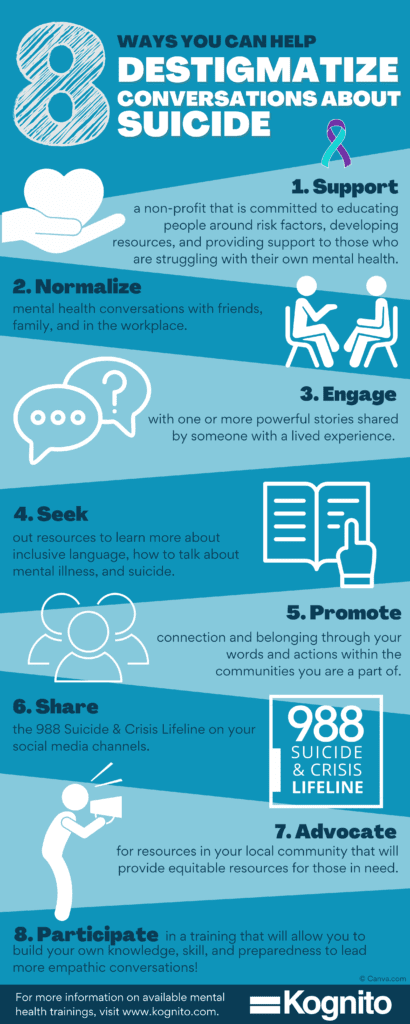Strategies for Destigmatizing the Conversation Around Suicide Prevention
In order to reduce a stigma, we must actively spread awareness, share resources, and normalize the conversation. Suicide and mental health are often stigmatized, meaning that it’s viewed in a very negative way or may not be seen as a major issue. The stigma around mental health can lead to harmful effects on people, including reluctance to seek help when needed.
There are many steps an individual can take to help combat the stigma around mental health conditions and suicide. In this infographic, we’ve outlined eight ways you can help destigmatize the conversation around suicide prevention.

Breaking the Stigma
What can we do to help raise awareness and to become better informed?
1. Support a non-profit that is committed to educating people around risk factors, developing resources, and providing support to those who are struggling with their own mental health.
Organizations such as the National Alliance on Mental Illness (NAMI), Active Minds, Crisis Text Line, and American Foundation for Suicide Prevention (AFSP) are all groups that work to support mental health awareness and education.
2. Normalize mental health conversations with friends, family, and in the workplace.
Continuing these conversations on sensitive topics such as mental health and suicide can create a lasting impact and it creates a platform for change. Talking openly about mental health and providing helpful resources helps to diminish the discrimination people feel when it comes to emotional distress.
3. Engage with one or more powerful stories shared by someone with a lived experience.
Many people, even celebrities, have shared stories of their experiences with mental health challenges. NAMI has a page on their website specially for people to share their personal stories of how mental illness and suicide have affected their life. Read here for more.
4. Seek out resources to learn more about inclusive language, how to talk about mental illness, and suicide.
Many mental health organizations provide resources for others to utilize and share to create awareness and reduce the stigma. AFSP, Samaritanshope.org, the CDC, and SAMHSA have pages dedicated to suicide prevention and mental health resources.
5. Promote connection and belonging through your words and actions within the communities you are a part of.
Social media is a great way to raise awareness and start conversations on important topics such as suicide prevention. We encourage you to share our “8 Ways You Can Help Destigmatize Conversations Around Suicide” infographic on your social media platforms to inform others and create a sense of belonging for those who may be struggling with mental health.
6. Share the 988 Suicide & Crisis Lifeline on your social media channels.
Along with the 998 Lifeline, check out this blog post to see list of crisis lines for those experiencing emotional distress.
7. Advocate for resources in your local community that will provide equitable resources for those in need.
Does your state or local community offer mental health resources? The American Foundation for Suicide Prevention (AFSP) encourages advocates to sign up as a volunteer for suicide prevention. By signing up, you become a vital part of AFSP’s advocacy network and will be given the resources and tools you need to speak out for mental health and suicide prevention at all levels of government. Learn more here.
8. Participate in a training that will allow you to build your own knowledge, skill, and preparedness to lead more empathetic conversations!
It’s vital to stay informed about the best way to conduct these conversations, specifically with students and young adults who may be experiencing emotional distress or struggling with their mental health. For more information on experiential learning programs for your school district or university, learn more about our solutions for PK-12 and Higher Education.
Raising awareness and sharing resources can really make a difference, and even save lives. For more information on suicide prevention resources, as well as products focused on emotional and mental wellness, visit www.kognito.com or contact us to learn more.